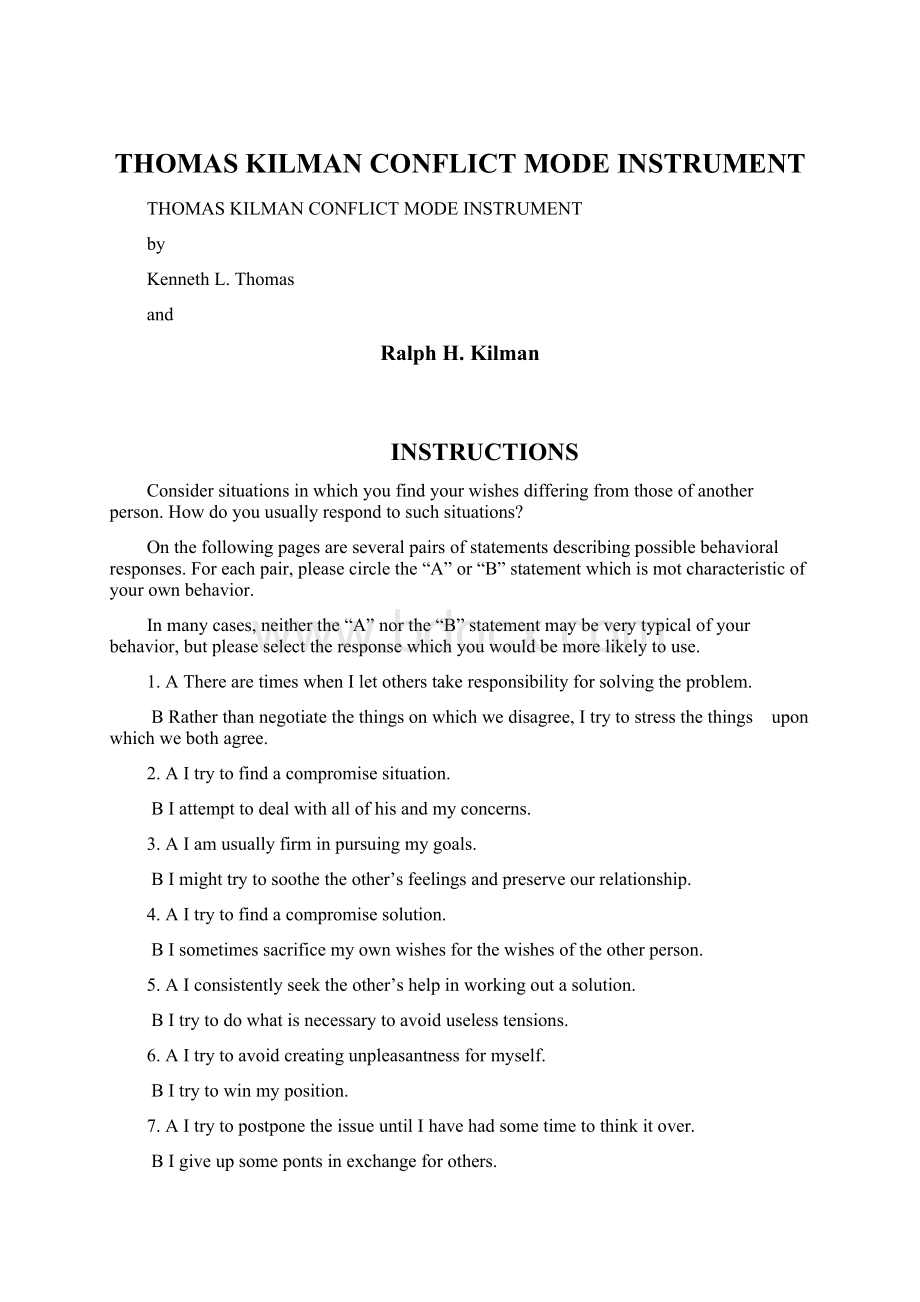THOMAS KILMAN CONFLICT MODE INSTRUMENT.docx
《THOMAS KILMAN CONFLICT MODE INSTRUMENT.docx》由会员分享,可在线阅读,更多相关《THOMAS KILMAN CONFLICT MODE INSTRUMENT.docx(14页珍藏版)》请在冰豆网上搜索。

THOMASKILMANCONFLICTMODEINSTRUMENT
THOMASKILMANCONFLICTMODEINSTRUMENT
by
KennethL.Thomas
and
RalphH.Kilman
INSTRUCTIONS
Considersituationsinwhichyoufindyourwishesdifferingfromthoseofanotherperson.Howdoyouusuallyrespondtosuchsituations?
Onthefollowingpagesareseveralpairsofstatementsdescribingpossiblebehavioralresponses.Foreachpair,pleasecirclethe“A”or“B”statementwhichismotcharacteristicofyourownbehavior.
Inmanycases,neitherthe“A”northe“B”statementmaybeverytypicalofyourbehavior,butpleaseselecttheresponsewhichyouwouldbemorelikelytouse.
1.ATherearetimeswhenIletotherstakeresponsibilityforsolvingtheproblem.
BRatherthannegotiatethethingsonwhichwedisagree,Itrytostressthethingsuponwhichwebothagree.
2.AItrytofindacompromisesituation.
BIattempttodealwithallofhisandmyconcerns.
3.AIamusuallyfirminpursuingmygoals.
BImighttrytosoothetheother’sfeelingsandpreserveourrelationship.
4.AItrytofindacompromisesolution.
BIsometimessacrificemyownwishesforthewishesoftheotherperson.
5.AIconsistentlyseektheother’shelpinworkingoutasolution.
BItrytodowhatisnecessarytoavoiduselesstensions.
6.AItrytoavoidcreatingunpleasantnessformyself.
BItrytowinmyposition.
7.AItrytopostponetheissueuntilIhavehadsometimetothinkitover.
BIgiveupsomepontsinexchangeforothers.
8.AIamusuallyfirminpursuingmygoals.
BIattempttogetallconcernsandissuesimmediatelyoutItheopen.
9.AIfeelthatdifferencesarenotalwaysworthworryingabout.
BImakesomeefforttogetmyway.
10.AIamfirminpursuingmygoals.
BItrytofindacompromisesolution.
11.AIattempttogetallconcernsandissuesimmediatelyoutintheopen.
BImighttrytosoothetheother’sfeelingsandpreserveourrelationship.
12.AIsometimesavoidtakingpositionswhichwouldcreatecontroversy.
BIwilllethimhavesomeofhispositionsifheletsmehavesomeofmine.
13.AIproposeamiddleground.
BIpresstogetmypointsmade.
14.AItellhimmyideasandaskhimforhis.
BItrytoshowhimthelogicandbenefitsofmyposition.
15.AImighttrytosoothetheother’sfeelingsandpreserveourrelationship.
BItrytodowhatisnecessarytoavoidtensions.
16.AItrynottohurttheother’sfeelings.
BItrytoconvincetheotherpersonofthemeritsofmyposition.
17.AIamusuallyfirminpursuingmygoals.
BIwilllethimhavesomeofhispositionsifheletsmehavesomeofmine.
18.AIfitmakestheotherpersonhappy,Imightlethimmaintainhisviews.
BIwilllethimhavesomeofhispositionsifheletsmehavesomeofmine.
19.AIattempttogetallconcernsandissuesimmediatelyoutintheopen.
BItrytopostponetheissueuntilIhavehadsometimetothinkitover.
20.AIattempttoimmediatelyworkthroughourdifferences.
BItrytofindafaircombinationofgainsandlossesfor
21AInapproachingnegotiations,Itrytobeconsiderateoftheotherperson’swishes.
BIalwaysleantowardadirectdiscussionoftheproblem.
22.AItrytofindapositionthatisintermediatebetweenhisandmine.
BIassertmywishes.
23.AIamveryoftenconcernedwithsatisfyingallourwishes.
BTherearetimeswhenIletotherstakeresponsibilityforsolvingtheproblem.
24.AIftheother’spositionseemsveryimportanttohim,Iwouldtrytomeethiswishes.
BItrytogethimtosettleforacompromise.
25.AItrytoshowhimthelogicandbenefitsofmyposition.
BInapproachingnegotiations,Itrytobeconsiderateoftheotherperson’swishes.
26.AIproposeamiddleground.
BIamnearlyalwaysconcernedwithsatisfyingallourwishes.
27.AIsometimesavoidtakingpositionsthatwouldcreatecontroversy.
BIfitmakestheotherpersonhappy,Imightlethimmaintainhisviews.
28.AIamusuallyfirminpursuingmygoals.
BIusuallyseektheother’shelpinworkingoutasolution.
29.AIproposeamiddleground.
BIfeelthatdifferencesarenotalwaysworthworryingabout.
30.AItrynottohurttheother’sfeelings.
BIalwayssharetheproblemwiththeotherpersonsothatwecanworkitout.
SCORING
Circlethelettersbelowwhichcorrespondtotheletteryourcircledoneachitemofthequestionnaireandthentotalthenumberofitemscircledineachcolumn.
Competing
(forcing)
Collaborating
(problemsolving)
Compromising
(sharing)
Avoiding
(withdrawal)
Accommodating
(soothing)
1.
-
-
-
A
B
2.
-
B
A
-
-
3.
A
-
-
-
B
4.
-
-
A
-
B
5.
-
A
-
B
-
6.
B
-
-
A
-
7.
-
-
B
A
-
8.
A
B
-
-
-
9.
B
-
-
A
-
10.
A
-
B
-
-
11.
-
A
-
-
B
12.
-
-
B
A
-
13.
B
-
A
-
-
14.
B
A
-
-
-
15.
-
-
-
B
A
16.
B
-
-
-
A
17.
A
-
-
B
-
18.
-
-
B
-
A
19.
-
A
-
B
-
20.
-
A
B
-
-
21.
-
B
-
-
A
22.
B
-
A
B
-
23.
-
A
-
B
-
24.
-
-
B
-
A
25.
A
-
-
-
B
26.
-
B
A
-
-
27.
-
-
-
A
B
28.
A
B
-
-
-
29.
-
-
A
B
-
30.
-
B
-
-
A
_______
_______
_______
_______
_______
Competing
Collaborating
Compromising
Avoiding
Accommodating
GRAPHINGYOURPROFILESCORES
Yourprofileofscoresindicatestherepertoireofconflicthandlingskillswhichyou,asanindividual,useinthekindsofconflictsituationsyouface.Yourscoreprofilecanbegraphedonthenextpageentitled,“YourScoresontheThomas-KilmanConflictModeInstrument.”
Thefivemodesarerepresentedbythefivecolumnslabeled“competing,”“collaborating,”andsoon.Inthecolumnundereachmodellabelistherangeofpossiblescoresonthatmode---from0(foreverylowuse)to12(forveryhighuse).Circleyourownscoresoneachofthefivemodes.
EachpossiblescoreisgraphedinrelationtothescoresofmanagerswhohavealreadytakentheThomas-KilmannConflictModeInstrument.Thehorizontallinesrepresentpercentiles–thepercentageofpeoplewhohavescoredatorbelowagivennumber.Ifyouhadscoredsomenumberabovethe“80%”lineoncompeting,forexample,thatwouldmeanthatyouhadscoredhigherthan80%ofthepeoplewhohavetakentheThomas-KilmannConflictModeInstrument–thatyouwereinthetop20%incompetition.
Thedoublelines(atthe25thand75thpercentiles)separatethemiddle50%ofthescoresoneachmodefromthetop25%andthebottom25%.Ingeneral,ifyourscorefallssomewherewithinthemiddle50%onagivenmode,youareclosetotheaverageinyouruseofthatmode.Ifyourscorefallsoutsidethatrange,thenyouruseofthatmodeissomewhathigherorlowerthanmostofthepeoplewhohavetakentheinstrument.Rememberthatextremescoresarenotnecessarilybad,however,sinceyoursituationmayrequirehighorlowuseofagivenconflict-handlingmode.
YOURSCORESONTHETHOMAS-KILMANNCONFLICTMODEINSTRUMENT
Competing
Collaborating
Compromising
Avoiding
Accommodating
100%-
--------
--------
--------
------
--------
-100%
12
12
12
12
11
11
11
12
11
10
10
High
25%
90%-
--------
--------
--------
------
--------
-90%
9
10
8
7
80%
--------
--------
--------
------
--------
-80%
=====
=====
========
=9=
========
======
=6=
=====
70%-
--7--
--------
--------
------
--------
-70%
60%-
--------
--------
--------
------
--------
-60%
6
8
5
7
6
Middle
50%
50%-
--------
--------
--------
------
--------
-50%
5
7
40%
--------
--------
--------
------
--------
-40%
4
6
5
4
30%
--------
--------
--------
------
--------
-30%
6
5
=====
=====
========
========
========
======
========
=====
3
4
3
20%-
--------
--------
--------
------
--------
-20%
5
4
2
3
Low
25%
10%-
--------
--------
--------
------
--------
-10%
1
0
4
3
2
1
0
3
2
1
0
2
1
0
2
1
0
0%
--------
--------
--------
------
--------
-0%
Scoresaregraphedinrelationtothescoresofthepracticingmanagersatmiddleandupperlevelsinbusinessandgovernmentorganizations.
INTERPRETINGYOURSCORESONTHETHOMAS-KILMANNCONFLICTMODEINSTRUMENT
TheFiveConflictHandlingModes
TheThomas-KilmannConflictModeInstrumentisdesignedtoassessanindividual’sbehaviorinconflictsituations.“ConflictSituations”arethesituationsinwhichtheconcernsoftwopeopleappeartobeincompatible.Insuchsituation,wecandescribeaperson’sbehavioralongtwobasicdimensions:
(1)assertiveness,theextenttowhichtheindividualattemptstosatisfyhisownconcerns,and
(2)cooperativeness,theextenttowhichtheindividualattemptstosatisfytheotherperson’sconcerns.Thesetwobasicdimensionsofbehaviorcanbeusedtodefinefivespecificmethodsofdealingwithconflicts.Thesefive“conflict-handlingmodes”areshownbelow:
Competing
Collaborating
A
●--------
------------
----●
s
Assertiveness
s
e
r
t
I
v
Compromising
e
●
s
Unassertives
s